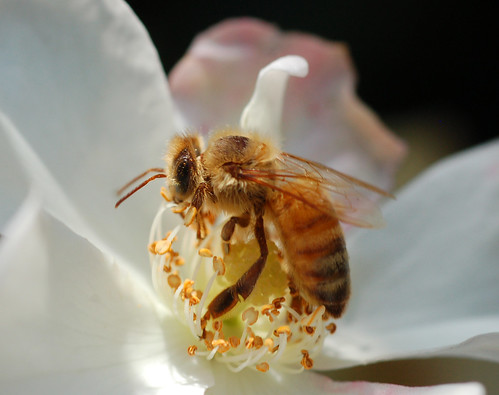Lethal Bee Hives

I read, today, about some really chilling findings about the health of honeybees in America. You may have heard of Colony Collapse Disorder (CCD) a mysterious (and deadly) malady which is affecting honeybees since 2006.
According to a paper published by the Public Library of Science, honeybees are under a lot of stress, because the honeycombs (in which they store their food, and raise their young) is seriously contaminated by agro-chemicals (pesticides used in crop fields and on orchards). Beekeepers had long suspected this to be one of the factors causing CCD.
The findings are -- to my mind -- pretty shocking.
When researchers sampled hives in 23 American states, almost 98% of the honey comb samples were contaminated with pesticides. Likewise, the pollen in sample hives were heavily contaminated with pesticides.
And we're not talking about just one kind of chemical. These hives were a toxic brew. On average, the hives sampled showed contamination by six different pesticides. In some cases, there were as many as 39 different pesticides in a single hive. This study found ONE HUNDRED AND TWENTY ONE different pesticides in the 887 hives tested across the nation.
Okay, so let's back up and discuss what a "systemic pesticide" is, and why I think we all need to pay attention to this issue.
According to Wikipedia, "A systemic pesticide moves inside a plant following absorption by the plant." That means that the poison that's sprayed on a tomato plant is absorbed by the entire plant, INCLUDING THE FRUIT, AND THE POLLEN, AND THE NECTAR.
What does it do to other organisms?
Who knows?
So when a bee collects nectar and pollen from a plant treated with a systemic pesticide, that bee is bringing chemicals back to the hive. The nectar is being converted into honey, which is CONTAMINATED WITH PESTICIDES. These pesticides are not merely honey contaminants (poisoning human food sources), but they are also (duh) poisonous to bees.
Bees are known to fly miles, in order to forage, which means that there's no way of keeping bees off of treated crops. Besides, farmers NEED bees to pollinate their crops.
No pollination = no food for humans.
What's most chilling is that some of the newest systemic pesticides which are proving most lethal to bees were rushed to market in 2006 (which coincidentally was the first year that CCD was observed), without the usual scrutiny by Federal regulators.
Bayer Crop Science started petitioning the agency to approve a new pesticide for sale in 2006. After reviewing the company's studies of its effects on bees, the EPA gave Bayer conditional approval to sell the product two years later, but said it had to carry a label warning that it was "potentially toxic to honey bee larvae through residues in pollen and nectar."
The Natural Resources Defense Council sued, saying the agency failed to give the public timely notice for the new pesticide application. In December, a federal judge in New York agreed, banning the pesticide's sale and earlier this month, two more judges upheld the ruling...The pesticide was sold for only about a year and most sales were in California, Arizona and Florida. The product is intended to disrupt the mating patterns of insects that threaten citrus, lettuce and grapes.
I'm dismayed and disgusted by this what this story says about our food supply, and about the lack of oversight on the part of Federal regulators. I could say a whole lot more on this topic (and I'm sure I will), but I've got to get to work.
I welcome everyone's comments on this topic.

Comments
http://www.dispatch.com/live/content/local_news/stories/2010/03/25/scary-spring.html
-Rose
Leapin' Lizards
Not a uplifting thought at all!
Lisa
My Pennsylvania dutch neighbors dont use and pesticides, so it's long overdue, I suspect!
Annalisa